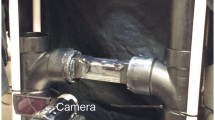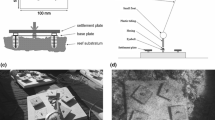Abstract
Settlement of larvae on floating objects and subsequent rafting of colonies provides a mechanism by which corals can bridge immense geographic distances. Reproductively mature colonies, several years in age, have been found attached to material that drifted into Hawaiian waters. During their lifetime, these corals may have traversed a total distance of from 20,000 to 40,000 km and could have completed several circuits of the tropical and subtropical Pacific basin. The ability of coral larvae to drift across vast stretches of open ocean probably does not determine the ultimate range limitation for zoogeographic dispersal of corals.
Similar content being viewed by others
References
Atoda K (1947) The larva and postlarval development of some reefbuilding corals. I. Pocillopora damicornis cespitosa (Dana). Sci Rep Tohoku Univ (4th Ser) 18:24–47
Atoda K (1951) The larvae and postlarval development of reef building corals. III. Acropora bruggemanni. J Morphol 89:1–16
Bertelsen E, Ussing H (1936) Marine tropical animals carried to the Copenhagen Sydhavn on a ship from the Bermudas. Dansk Naturhistorisk Forening i Kjobenharn Videnskabelige Meddelelser 100:237–245
Crossland C (1952) Madreporia, Hydrocorallnae, Heliopora and Tubipora. Br Mus Nat Hist Great Barrier Reef Exped 1928–29, Sci Rep 6:86–257
Dana TF (1975) Development of contemporary Eastern Pacific coral reefs. Mar Biol 33:355–374
Ekman S (1953) Zoogeography of the sea. Sidgwick & Jackson, London
Grigg RW (1981) Acropora in Hawaii. II. Zoogeography. Pac Sci 35:15–24
Grigg RW, Wells JW, Wallace C (1981) Acropora in Hawaii. I. History of the scientific record, systematics and ecology. Pac Sci 35:1–13
Guppy HB (1889) The Cocos-Keeling Islands. Scott Geogr Mag 5:281–297
Harrigan JF (1972) The planula larvae of Pocillopora damicornis: lunar periodicity of swarming and substratum selection behavior. PhD thesis, University of Hawaii, Honolulu
Harrison PL, Babcock RC, Bull GD, Oliver JK, Wallace CC, Willis BL (1984) Mass spawning in tropical reef corals. Science 223:1186–1189
Maragos JE (1977) Order Scleractinia. In Reef and shore fauna of Hawaii. I. Protozoa through Ctenophora. Bernice P Bishop Mus Spec Publ 64:158–241
Polacheck T (1978) The population biology of four common Hawaiian corals. MS thesis, University of Hawaii, Honolulu
Richards AF (1958) Transpacific distribution of floating pumice from Isla San Benedicto, Mexico. Deep-Sea Res 5:29–35
Richards AF (1966) Geology of the Islas Revillagigedo, Mexico. II. Geology and petrography of Isla San Benedicto. Proc Calif Acad Sci 33:361–414
Richmond R (1981) Energetic considerations in the dispersal of Pocillopora damicornis (Linnaeus) planulae. Proc 4th Int Coral Reef Symp 2:153–156
Richmond R (1983) Reproduction, larval physiology and dispersal potential of the coral Pocillopora damicornis. PhD thesis, State University of New York at Stony Brook
Rinkevich B, Loya Y (1979) The reproduction of the Red Sea coral Stylophora pistillata. I. Gonads and planulae. Mar Ecol Prog Ser 1:133–144
Rotondo GM, Springer VG, Scott GAJ, Schlanger SO (1981) Plate movement and island integration — a possible mechanism in the formation of endemic biotas, with special reference to the Hawaiian Islands. Syst Zool 30:12–21
Roy KJ, Smith SV (1970) Note on growth of Pocillopora ligulata. Hawaii Institute of Geophysics Tech Report HIG-70-23, Honolulu, Hawaii, pp 179–188
Stimson J (1978) Mode and timing of reproduction in some common hermatypic corals of Hawaii and Enewetak. Mar Biol 48:173–184
Stoddart JA (1983) The asexual production of planulae in the coral Pocillopora damicornis. Mar Biol 76:279–286
Weather Bureau Commerce Department (1961) Climatological and oceanographic atlas for mariners, vol 2: North Pacific Ocean. Prepared by Office of Climatology and Oceanographic Analysis Division US Government Printing Office, Washington, DC
Wilson JT (1963) A possible origin of the Hawaiian Islands. Can J Phys 41:863–870
Wood AL (1975) Beachcombing for Japanese glass floats, 3rd edn. Binfort and Mort, Portland, Oregon
Wood-Jones F (1907) On the growth forms and supposed species in corals. Proc Zool Soc London, pp 518–556
Author information
Authors and Affiliations
Additional information
Hawaii Institute of Marine Biology Contribution Number 685
Rights and permissions
About this article
Cite this article
Jokiel, P.L. Long distance dispersal of reef corals by rafting. Coral Reefs 3, 113–116 (1984). https://doi.org/10.1007/BF00263761
Accepted:
Issue Date:
DOI: https://doi.org/10.1007/BF00263761




